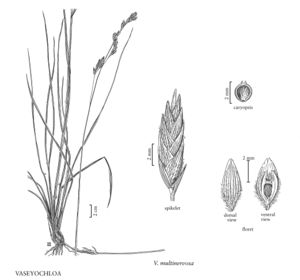Difference between revisions of "Vaseyochloa multinervosa"
imported>Volume Importer |
imported>Volume Importer |
||
| Line 43: | Line 43: | ||
|publication year= | |publication year= | ||
|special status=Endemic | |special status=Endemic | ||
| − | |source xml=https://bitbucket.org/aafc-mbb/fna-data-curation/src/ | + | |source xml=https://bitbucket.org/aafc-mbb/fna-data-curation/src/200273ad09963decb8fc72550212de541d86569d/coarse_grained_fna_xml/V25/V25_173.xml |
|subfamily=Poaceae subfam. Chloridoideae | |subfamily=Poaceae subfam. Chloridoideae | ||
|tribe=Poaceae tribe Cynodonteae | |tribe=Poaceae tribe Cynodonteae | ||
Latest revision as of 18:58, 11 May 2021
Culms 60-110 cm. Ligules 1-3 mm; blades 16-35 cm long, 1-6 mm wide, glabrous, lower blades usually folded, upper blades flat. Panicles 10-30 cm long, 1-3 cm wide; branches 4-13 cm, ascending or the lower branches occasionally spreading, each axil with a tuft of hairs. Spikelets 10-16 mm long, 2.5-5 mm wide. Lower glumes 2.5-4 mm, 1-7-veined; upper glumes 4-5.5 mm, 5-9-veined; lemmas 5-7 mm; anthers 3, 0.5-2 mm. 2n = 56, 60, 68.
Discussion
Vaseyochloa multinervosa grows in islands of live oaks within rolling sand dunes on the Texas mainland, North Padre Island, and on naturally occurring islands in the Laguna Madre of Texas.
Selected References
None.
Lower Taxa
None.
